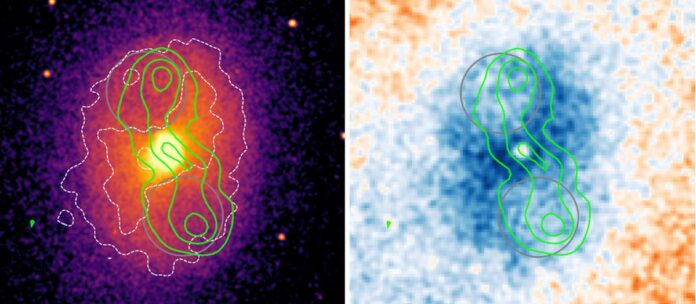Astronomers have observed the effect of a distant feeding black hole that is burping out tremendous amounts of energy and blowing huge cosmic bubbles in its surrounding material.
The observations of the galactic cluster MS0735 located 2.6 billion light-years away could reveal new information about mysterious cavities or “radio bubbles” that surround the black hole and why they don’t simply collapse like a deflated balloon under pressure from their surroundings.
“We’re looking at one of the most energetic outbursts ever seen from a supermassive black hole,” research lead author and McGill University physicist Jack Orlowski-Scherer, said in a statement (opens in new tab). “This is what happens when you feed a black hole and it violently burps out a giant amount of energy.”
Related: 15 times black holes surprised us in 2022
Supermassive black holes are found at the heart of most massive galaxies including the Milky Way which houses the supermassive black hole Sagittarius A* (Sgr A*) at its center.
These home galaxies and their supermassive black hole inhabitants are often found together in groupings of hundreds or even thousands, gatherings called galactic clusters.
These clusters are also home to atmospheres that fill the space between galaxies with incredibly hot gas or plasma at temperatures as great as around 90 million degrees Fahrenheit (50 million degrees Celsius). Though this plasma can cool over time and allow cold dense gas to form and eventually collapse to birth new stars, feeding black holes can work against this process.
Supermassive black holes can reheat this gas through violent outbursts of material. These outflows occur when some of this matter isn’t swallowed by the black hole but is instead dragged to its poles from where it is blasted out at near the speed of light. This process, known as “feedback,” quenches the formation of new stars with the jets of material also carving out cavities in surrounding gas.
As this gas is pushed away from the center of galactic clusters it is replaced by bubbles that emit radio waves.
The shifting of these huge volumes of gas requires a massive amount of energy in turn and astronomers have been endeavoring to understand where this energy comes from in addition to discovering what is left behind in these evacuated cavities.
To learn more about such gas bubbles in galactic clusters and the processes that create them the team of astronomers including Orlowski-Scherer trained the Green Bank Telescope’s MUSTANG-2 receiver on the cluster MS0735. The Green Bank Telescope observations were complemented by X-ray data collected previously from MS0735 by NASA’s Chandra X-ray Observatory.
They also employed a subtle distortion effect that rapidly moving electrons in the hot cluster gas have on the Cosmic Microwave Background (CMB) a field of radiation left over from an event shortly after the Big Bang that evenly fills the universe.
This effect on this fossil radiation that was emitted 380,000 years after the beginning of the universe when the cosmos had expanded and cooled enough to allow electrons to bond with protons creating the first atoms thus allowing photons to travel freely creating the “first light” is called the Sunyaev-Zeldovich (SZ) effect.
MUSTANG-2 conducts its observations at 90 GHz a frequency at which the SZ effect signal represents mainly thermal pressure.
“With the power of MUSTANG-2, we are able to see into these cavities and start to determine precisely what they are filled with, and why they don’t collapse under pressure,” research collaborator and European Southern Observatory (ESO) astronomer Tony Mroczkowski explained.
The team determined that at least a portion of the support that prevents cavities from collapsing comes from things other than heat, with these non-thermal sources including particles traveling at near-light speed, high-speed charged particles called cosmic rays, and turbulence. They also found a small contribution comes from magnetic fields.
This implies that by mixing thermal and non-thermal sources pressure support within radio bubbles around supermassive black holes is more nuanced than previously thought.
The team of astronomers now aims to observe the same system over different frequencies of electromagnetic radiation to see just how exotic the black hole outflow is and gain a deeper insight into the physics of galactic clusters.
“These new findings are the deepest high-fidelity SZ imaging yet of the thermodynamic state of cavities in a galaxy cluster,” research co-author and U.S. Naval Research Laboratory astronomer, Tracy Clarke, added. “We knew this was an exciting system when we studied the radio core and lobes at low frequencies, but we are only now beginning to see the full picture.”
The team’s research is published in the latest edition of the journal Astronomy & Astrophysics (opens in new tab).
Follow us on Twitter @Spacedotcom or on Facebook.

